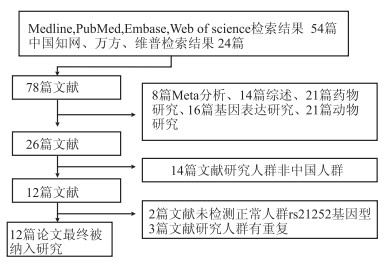rs12252 polymorphism of IFITM3 gene and influenza susceptibility in Chinese population: a study-based sequential Meta-analysis
-
摘要:
目的 系统评价干扰素诱导跨膜蛋白3(interferon-induced transmembrane protein 3,IFITM3)基因rs12252位点多态性与中国人群流感易感性的定量关系。 方法 检索Medline、PubMed、Embase、Web of Science以及中国知网、万方、维普数据库,收集IFITM3与中国人群流感易感性相关的文章。采用Meta分析方法对收集的文章进行定量地综合分析。 结果 本次研究共纳入7篇文献,共计919例流感感染的病例,涉及到甲型流感(H7N9、H1N1pmd09、H3N2)及乙型流感病毒,序贯Meta分析显示本研究纳入的研究总样本已达到了得到稳定阳性结局所需的样本量。Meta分析结果发现,IFITM3基因的rs12252多态性与中国人群流感病毒易感性存在关联,携带rs12252 C等位基因的人群更易发生流感(C vs T:OR=1.67,95% CI:1.45~1.92;CC vs TT:OR=2.61,95% CI:1.97~3.46;TC vs TT:OR=1.55,95% CI:1.20~2.00;CC vs TC+TT:OR=2.01,95% CI:1.49~2.72;CC+TC vs TT:OR=8.90,95% CI:4.94~16.06)。 结论 IFITM3基因rs12252位点多态性是中国人群发生流感的危险因素。 -
关键词:
- IFITM3 /
- rs12252位点多态性 /
- 流感 /
- Meta分析 /
Abstract:Objective To systematically and quantitatively evaluate the relationship of rs12252 polymorphism in IFITM3 gene and susceptibility to influenza in Chinese population. Methods The databases of Medline, PubMed, Embase, Web of Science, China National knowledge infrastructure (CNKI), Wanfang and VIP were searched to retrieve the articles which focused on the topic of relationship between the rs12252 polymorphism and susceptibility to influenza in Chinese population. Meta-analysis method was used to comprehensively and quantitatively analyze the enrolled articles. Results Seven papers with a total of 919 influenza cases were involved in this article. Influenza virus involved influenza A (H7N9, H1N1 pmd09, H3N2) and influenza B. Study-based sequential meta-analysis of the study showed that the total sample size of this study have achieved the required sample size to obtain stable positive results. The results of this meta-analysis showed that the rs12252 polymorphism was associated with susceptibility to influenza in Chinese population and that the rs12252C polymorphism in IFITM3 gene was more susceptible to have influenza in Chinese people (C vs T: OR=1.67, 95% CI: 1.45-1.92; CC vs TT: OR=2.61, 95% CI: 1.97-3.46; TC vs TT: OR=1.55, 95% CI: 1.20-2.00; CC vs TC+TT: OR=2.01, 95% CI: 1.49-2.72; CC+TC vs TT: OR=8.90, 95% CI: 4.94-16.06). Conclusion the rs12252 polymorphism of IFITM3 gene was a risk factor for influenza in Chinese population. -
Key words:
- IFITM3 /
- rs12252 /
- Polymorphism /
- Influenza /
- Meta-analysis
-
表 1 研究纳入文献的基本信息
Table 1. Basic information of the included studies
作者 发表年 研究对象 流感型别 流感病例基因分型 正常人群基因分型 TT TC CC TT TC CC Jianbing Zheng[19] 2016 儿童 未分型 6 25 29 49 98 50 Lee[10] 2017 成人 H7N9 11 25 15 28 48 29 H1N1pmd09 51 90 83 28 48 29 Qiaowei Zhu[20] 2013 儿童 Influenza 6 29 9 73 72 52 Yang Pan[21] 2016 全年龄组 H3N2 8 45 53 16 34 15 Yamagata 10 19 24 16 34 15 H1N1pmd09 3 4 11 16 34 15 YongHong Zhang[22] 2012 全年龄组 H1N1pmd09 9 39 35 49 98 50 Yongkun Chen[23] 2017 全年龄组 Influenza B 50 130 84 27 57 19 Zhongfang Wang[24] 2014 成人 H7N9 3 7 6 24 49 20 表 2 研究纳入文献的质量评价
Table 2. Quality evaluation of the included studies
表 3 rs12252基因多态性与中国人群流感易感性的关系(流感组vs正常人群组)
Table 3. Relationship between rs12252 polymorphism and influenza susceptibility in Chinese population (influenza group vs normal group)
病毒亚型 遗传模型 研究数目 OR值(95% CI) P值 Q值 Ph值 I2值 PEGGERa值 统计模型 流感 等位基因模型(C/T) 10 1.67(1.45~1.92) < 0.001 12.300 0.197 26.83 0.427 固定 流感 共显性模型1 (CC/TT) 10 2.61(1.97~3.46) < 0.001 11.006 0.275 18.23 0.549 固定 流感 共显性模型2 (TC/TT) 10 1.55(1.20~2.00) 0.001 13.339 0.148 32.53 0.837 固定 流感 隐性模型(CC/TC+TT) 10 2.01(1.49~2.72) < 0.001 16.751 0.053 46.27 0.567 随机 流感 显性模型(CC+TC/TT) 10 8.9(4.94~16.06) < 0.001 36.213 <0.001 75.15 0.889 随机 甲型流感 等位基因模型(C/T) 7 1.63(1.37~1.93) < 0.001 10.146 0.119 40.86 0.547 固定 甲型流感 共显性模型1 (CC/TT) 7 2.44(1.72~3.46) < 0.001 9.291 0.158 35.42 0.549 固定 甲型流感 共显性模型2 (TC/TT) 7 1.71(1.06~2.76) 0.001 11.053 0.087 45.71 0.771 随机 甲型流感 隐性模型(CC/TC+TT) 7 1.83(1.38~2.30) 0.006 14.358 0.026 58.21 0.642 随机 甲型流感 显性模型(CC+TC/TT) 7 10.45(7.68~14.22) < 0.001 2.047 0.915 0.00 0.134 固定 乙型流感 等位基因模型(C/T) 2 1.58(1.20~2.08) 0.001 0.251 0.617 0.00 - 固定 乙型流感 共显性模型1 (CC/TT) 2 2.44(1.38~4.30) 0.002 0.012 0.911 0.00 - 固定 乙型流感 共显性模型2 (TC/TT) 2 1.14(0.70~1.85) 0.610 0.314 0.575 0.00 - 固定 乙型流感 隐性模型(CC/TC+TT) 2 2.26(1.43~3.58) 0.001 0.345 0.557 0.00 - 固定 乙型流感 显性模型(CC+TC/TT) 2 0.41(0.00~1027.55) 0.823 28.748 < 0.001 96.52 随机 注:a文献数少于3篇将不检验发表偏倚。 -
[1] Tanushree D, Amita J. Influenza virus: a brief overview[J]. Proc Natl Acad Sci Sect B Biol Sci, 2012, 82(1): 111-121. DOI: 10.1007/s40011-011-009-6. [2] Fukuyama S, Kawaoka Y. The pathogenesis of influenza virus infections: the contributions of virus and host factors[J]. Curr Opin Immunol, 2011, 23(4): 481-486. DOI: 10.1016/j.coi.2011.07.016. [3] Tscherne DM, Garcia-Sastre A. Virulence determinants of pandemic influenza viruses[J]. J Clin Invest, 2011, 121(1): 6-13. DOI: 10.1172/JCI44947. [4] Wellington D, Laurenson-Schafer H, Abdel-Haq A, et al. IFITM3: how genetics influence influenza infection demographically[J]. Biomed J, 2019, 42(1): 19-26. DOI: 10.1016/j.bj.2019.01.004. [5] Desai TM, Marin M, Chin CR, et al. IFITM3 restricts influenza A virus entry by blocking the formation of fusion pores following virus-endosome hemifusion[J]. PLoS Pathog, 2014, 10(4): e1004048. DOI: 10.1371/journal.ppat.1004048. [6] Wakim LM, Gupta N, Mintern JD, et al. Enhanced survival of lung tissue-resident memory CD8(+) T cells during infection with influenza virus due to selective expression of IFITM3[J]. Nat Immunol, 2013, 14(3): 238-245. DOI: 10.1038/ni.2525. [7] Brass AL, Huang IC, Benita Y, et al. The IFITM proteins mediate cellular resistance to influenza A H1N1 virus, west nile virus, and dengue virus[J]. Cell, 2009, 139(7): 1243-1254. DOI: 10.1016/j.cell.2009.12.017. [8] Randolph AG, Yip WK, Allen EK, et al. Evaluation of IFITM3 rs12252 association with severe pediatric influenza infection[J]. J Infect Dis, 2017, 216(1): 14-21. DOI: 10.1093/infdis/jix242. [9] Williams DE, Wu WL, Grotefend CR, et al. IFITM3 polymorphism rs12252-C restricts influenza A viruses[J]. PLoS One, 2014, 9(10): e110096. DOI: 10.1371/journal.pone.0110096. [10] Lee N, Cao B, Ke C, et al. IFITM3, TLR3, and CD55 gene SNPs and cumulative genetic risks for severe outcomes in Chinese patients with H7N9/H1N1pdm09 Influenza[J]. J Infect Dis, 2017, 216(1): 97-104. DOI: 10.1093/infdis/jix235. [11] David S, Correia V, Antunes L, et al. Population genetics of IFITM3 in portugal and central africa reveals a potential modifier of influenza severity[J]. Immunogenetics, 2018, 70(3): 169-177. DOI: 10.1007/s00251-017-1026-2. [12] Mehrbod P, Eybpoosh S, Fotouhi F, et al. Association of IFITM3 rs12252 polymorphisms, BMI, diabetes, and hypercholesterolemia with mild flu in an Iranian population[J]. Virol J, 2017, 14(1): 218. DOI: 10.1186/s12985-017-0884-4. [13] Gaio V, Nunes B, Pechirra P, et al. Hospitalization risk due to respiratory illness associated with genetic variation at IFITM3 in patients with influenza A(H1N1)pdm09 infection: a case-control study[J]. PLoS One, 2016, 11(6): e0158181. DOI: 10.1371/journal.pone.0158181. [14] López-Rodríguez M, Herrera-Ramos E, Solé-Violán J, et al. IFITM3 and severe influenza virus infection, no evidence of genetic association[J]. Eur J Clin Microbiol Infect Dis, 2016, 35(11): 1811-1817. DOI: 10.1007/s10096-016-2732-7. [15] Mills TC, Rautanen A, Elliott KS, et al. IFITM3 and susceptibility to respiratory viral infections in the community[J]. J Infect Dis, 2014, 209(7): 1028-1031. DOI: 10.1093/infdis/jit468. [16] Kim YC, Jeong BH. No Correlation of the disease severity of influenza A virus infection with the rs12252 polymorphism of the interferon-induced transmembrane protein 3 gene[J]. Intervirology, 2017, 60(1-2): 69-74. DOI: 10.1159/000479087. [17] Carter TC, Hebbring SJ, Liu J, et al. Pilot screening study of targeted genetic polymorphisms for association with seasonal influenza hospital admission[J]. J Med Virol, 2018, 90(3): 436-446. DOI: 10.1002/jmv.24975. [18] Wetterslev J, Thorlund K, Brok J, et al. Trial sequential analysis may establish when firm evidence is reached in cumulative meta-analysis[J]. J Clin Epidemiol, 2008, 61(1): 64-75. DOI: 10.1016/j.jclinepi.2007.03.013. [19] 郑建斌, 张剑珲, 陶建平, 等. 干扰素诱导跨膜蛋白3基因多态性与小儿流感严重程度相关性研究[J]. 生物医学工程学进展, 2016, 37(2): 66-69. DOI: 10.3969/j.issn.1674-1242.2016.02.002.Zheng JB, Zhang JH, Tao JP, et al. Association of interferon inducible transmembrane protein 3 gene polymorphism with the severity of influenza in children[J]. Progress in Biomedical Engineering, 2016, 37(2): 66-69. DOI: 10.3969/j.issn.1674-1242.2016.02.002. [20] 朱乔伟. 干扰素诱导的跨膜蛋白3基因rs12252 T/C多态性与儿童流感遗传易患性和严重性的相关性研究[D]. 广州: 广州医学院, 2013.Zhu QW. Correlation of rs12252 T/C polymorphism in the interferon induced transmembrane protein 3 gene and genetic susceptibility and severity in children with influenza[D]. Guangzhou: Guangzhou Medical College, 2013. [21] 潘阳, 杨鹏, 张奕, 等. 干扰素诱导跨膜蛋白3 rs12252多态性与乙型流感病毒感染相关性研究[J]. 国际病毒学杂志, 2016, 23(6): 364-367. DOI: 10.3760/cma.j.issn.1673-4092.2016.06.002.Pan Y, Yang P, Zhang Y, et al. The association between IFITM3 rs12252 polymorphism and influenza B virus infection[J]. Int J Virol, 2016, 23(6): 364-367. DOI: 10.3760/cma.j.issn.1673-4092.2016.06.002. [22] Zhang YH, Zhao Y, Li N, et al. Interferon-induced transmembrane protein-3 genetic variant rs12252-C is associated with severe influenza in Chinese individuals[J]. Nat Commun, 2013, 4: 1418. DOI: 10.1038/ncomms2433. [23] 陈永坤, 朱闻斐, 郭俊峰, 等. 干扰素诱导跨膜蛋白3 rs12252单核苷酸多态性与乙型流感临床严重程度的相关性研究[J]. 病毒学报, 2017, 33(3): 389-393. DOI: 10.13242/j.cnki.bingduxuebao.003161.Chen YK, Zhu WF, Guo JF, et al. The association between IFITM3 rs12252 gene polymorphism and severity of influenza B virus infection[J]. Chin J Virol, 2017, 33(3): 389-393. DOI: 10.13242/j.cnki.bingduxuebao.003161. [24] Wang ZF, Zhang AL, Wan YM, et al. Early hypercytokinemia is associated with interferoninduced transmembrane protein-3 dysfunction and predictive of fatal H7N9 infection[J]. PNAS, 2014, 111(2): 769-774. DOI: 10.1073/pnas.1321748111. [25] 侯志飞, 赵学森. 干扰素诱导跨膜蛋白抗病毒机制研究进展[J/CD]. 中华实验和临床感染病杂志(电子版), 2018, 12(3): 212-215. DOI: 10.3877/cma.j.issn.1674-1358.2018.03.002.Hou ZF, Zhao XS. Advances in antiviral study on interferon-induced transmembrane protein[J/CD]. Chin J Exp Clin Infect Dis (Electronic Edition), 2018, 12(3): 212-215. DOI: 10.3877/cma.j.issn.1674-1358.2018.03.002. [26] Prabhu SS, Chakraborty TT, Kumar N, et al. Association between IFITM3 rs12252 polymorphism and influenza susceptibility and severity: a meta-analysis[J]. Gene, 2018(674): 70-79. DOI: 10.1016/j.gene.2018.06.070. [27] Brass AL, Huang IC, Benita Y, et al. The IFITM proteins mediate cellular resistance to influenza A H1N1 virus, west nile virus, and dengue virus[J]. Cell, 2009, 139(7): 1243-1254. DOI: 10.1016/j.cell.2009.12.017. [28] Schoggins JW, Wilson SJ, Panis M, et al. A diverse range of gene products are effectors of the type I interferon antiviral response[J]. Nature, 2011, 472(7344): 481-485. DOI: 10.1038/nature09907. [29] Chen L, Borozan I, Feld J, et al. Hepatic gene expression discriminates responders and nonresponders in treatment of chronic hepatitis C viral infection[J]. Gastroenterology, 2005.128(5): 1437-1444. DOI: 10.1053/j.gastro.2005.01.059. [30] Huang IC, Bailey CC, Weyer JL, et al. Distinct patterns of IFITM-mediated restriction of filoviruses, SARS coronavirus, and influenza A virus[J]. PLoS Pathog, 2011, 7(1): e1001258. DOI: 10.1371/journal.ppat.1001258. [31] Wilkins C, Woodward J, Lau DT, et al. IFITM1 is a tight junction protein that inhibits hepatitis C virus entry[J]. Hepatology, 2013, 57(2): 461-469. DOI: 10.1002/hep.26066. [32] Anafu AA, Bowen CH, Chin CR, et al. Interferon-inducible transmembrane protein 3(IFITM3) restricts reovirus cell entry[J]. J Biol Chem, 2013, 288(24): 17261-17271. DOI: 10.1074/jbc.M112.438515. [33] Compton AA, Bruel T, Porrot F, et al. IFITM proteins incorporated into HIV-1 virions impair viral fusion and spread[J]. Cell Host Microbe, 2014, 16(6): 736-47. DOI: 10.1016/j.chom.2014.11.001. [34] Chan YK, Huang IC, Farzan M. IFITM proteins restrict antibody-dependent enhancement of dengue virus infection[J]. PLoS One, 2012, 7(3): e34508. DOI: 10.1371/journal.pone.0034508. [35] Feeley EM, Sims JS, John SP, et al. IFITM3 inhibits influenza A virus infection by preventing cytosolic entry[J]. PLoS Pathog, 2011, 7(10): e1002337. DOI: 10.1371/journal.ppat.1002337. [36] Ouyang J, Zhu X, Chen Y, et al. NRAV, a long noncoding RNA, modulates antiviral responses through suppression of interferon-stimulated gene transcription[J]. Cell Host Microbe, 2014, 16(5): 616-626. DOI: 10.1016/j.chom.2014.10.001. [37] Everitt AR, Clare S, Pertel T, et al. IFITM3 restricts the morbidity and mortality associated with influenza[J]. Nature, 2012, 484(7395): 519-523. DOI: 10.1038/nature10921. [38] Pan Y, Yang P, Dong T, et al. IFITM3 Rs12252-C Variant Increases Potential Risk for Severe Influenza Virus Infection in Chianese Population[J]. Front Cell Infect Microbiol, 2017, 7: 294. DOI: 10.3389/fcimb.2017.00294. -





 下载:
下载:







